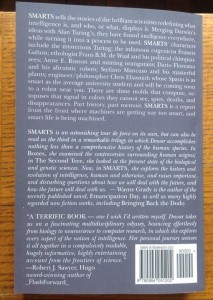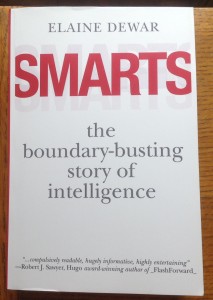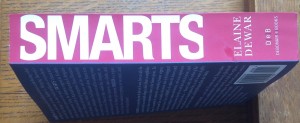Editing SMARTS Made Me Smarter; Reading it May Do the Same for You
Excited to note publication for all my readers here of a new nonfiction book I edited in manuscript, SMARTS: The Boundary-busting Story of Intelligence. It’s by the award-winning science writer and talented narrative journalist Elaine Dewar. A more expansive subtitle appears on the half-title page in the printed book the author just sent me:
Computing slime moulds, political primates, masterful plants, altruistic robots, amoeba machines, high IQ chips, philosophers of mind using screwdrivers,
signals, spies, the brilliant life and mysterious death of Alan Turing, and the boundary-busting story of intelligence.
An intellectually stimulating aspect of this edit was discovering that, in astonishing variety of ways, as Dewar writes, “the process of natural selection can lead to the evolution of adaptive behaviors.” I learned that these creative adaptations occur in even the most primitive life forms, such as the slime moulds referred to above. Even more startling are neural networks, a product of artificial intelligence, whose development Dewar chronicles.
“A neural network is a radically simplified computer version of the real thing. Real neurons build physical connections to neighbor neurons which link together in a network as they receive and send electrochemical signals back and forth. The more neuronal connections, and the greater the intensity of these interactions between neighbors, the stronger the information bond between them: thus, we learn. Neural network-style computation enables modern computers to learn by changing or weighting the frequency of interactions between one part of a network and another.”
Dewar earlier wrote BONES: Discovering the First Americans, on the ancient peopling of the Americas, and THE SECOND TREE: Clones, Chimeras and Quests for Immortality, a kind of nonfiction version of Margaret Atwood’s dystopian novel ORYX AND CRAKE. I published both those nonfiction books when I was with Carroll & Graf last decade, after they had been edited and published in Canada, where Dewar lives. Suffice to say, I relished the chance to finally edit one of her manuscripts!
While each of the earlier books dealt to a large extent with the human past, here Dewar—who in the course of writing SMARTS visited with and interviewed a dozen or more top thinkers, inventors, and scientists working in the Smart realm—synthesizes their work, boldly imagining where research and emerging technology may take intelligence in the years and decades to come.
SMARTS is published by a new company called Debonaire Books, and is available via this link in a quality paperback edition and as an ebook. I’m tickled to have a copy of the quality paperback, shown below, and especially excited that during a visit to Toronto later this month I’ll be attending a party to launch the book. Here’s what it looks like:



